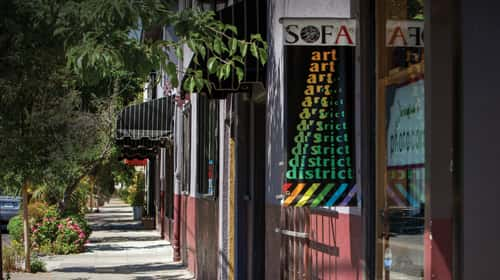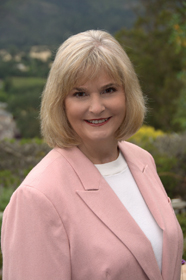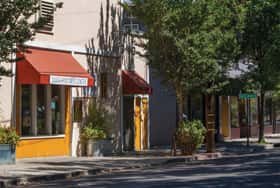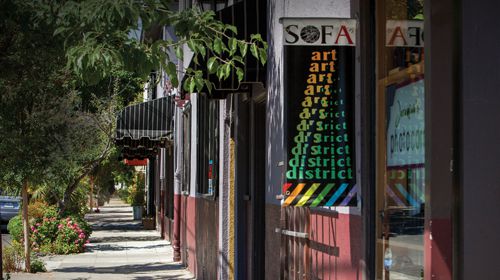
Gentrification is a mixed blessing. While the process, raising a blighted area to upper- or middle-class standards, may appeal to the affluent, the benefits are often at the expense of displacing the culturally diverse businesses and residents, which gave the place its unique character. In the North Bay, with a desperate housing shortage made even worse by the 2017 fires, displacement can mean homelessness—often of the very people that made the area attractive to developers in the first place—the artists and diverse population. The resulting up-scale homogeneity is not only consequential for the displaced, but for the neighborhood itself since it loses its creative vitality.
The paradox
 “It’s a paradoxical dynamic,” explains Jeanette Harrison, co-founder of AlterTheater in downtown San Rafael. “The arts come in, particularly to a blighted area, an area high in crime, high in vacancy rates, because that’s where we can afford to live and that’s where we can afford the space to do our work.” After a while, people start to gravitate to the art, music, and sense of community the arts bring. For a while, the renovated area thrives and then investment follows attraction. At some point comes the clearing and renovating of gentrification and then the very people who make the area special are priced out. Those with low or marginal incomes are most vulnerable.
“It’s a paradoxical dynamic,” explains Jeanette Harrison, co-founder of AlterTheater in downtown San Rafael. “The arts come in, particularly to a blighted area, an area high in crime, high in vacancy rates, because that’s where we can afford to live and that’s where we can afford the space to do our work.” After a while, people start to gravitate to the art, music, and sense of community the arts bring. For a while, the renovated area thrives and then investment follows attraction. At some point comes the clearing and renovating of gentrification and then the very people who make the area special are priced out. Those with low or marginal incomes are most vulnerable.
“Every single arts organization in the Bay Area is in an extremely precarious situation right now,” says Harrison. “All it takes is for us to lose our space. And if we have to pay market rates for rents, or if we have to try to buy a building, we’re out of business.”
The consequences come in various forms and not all effects of gentrification are as blatant as bulldozing a neighborhood and putting up a high-rise. Some effects are subtle. AlterTheater produces plays, which means they need space for performances. Early on, says Harrison, the San Rafael business community made their work possible, offering theater space practically for free.
“Local landlords would say, ‘You can use my building for three or four weeks, that’s fine. Make sure it’s insured to the gills and take good care of it.’” But now, she explains, money has moved in and there are just not many empty storefronts in San Rafael and many buildings are no longer owned locally. “They’re owned by large corporations and some of them are now owned by international companies,” she says. “They’re not that interested in supporting the community.”
In 2017, California Arts Council identified downtown San Rafael among 14 communities up and down the state of California as “cultural districts” for their culture of arts and diversity. By supporting the artists with modest grants and featuring them in publicity, the Arts Council intends to help keep artists in the community and sets an example for other areas by showing appreciation for the arts. While the attention and the grants do not equate to rent security for all, the recognition is a boost for morale and enticement for visitors who can enjoy and support the artists by coming to art walks, visiting shows and buying art at open studios. The benefits for the community are rich. “To have a healthy downtown, we need a thriving arts ecosystem,” says Harrison. “You need the visual arts; you need the performing arts; you need arts organizations. If you want to see Shakespeare, you can go to the Marin Shakespeare Company. If you want to see new theater, you can come to AlterTheater. If you want to see amazing independent film, The Rafael is one of the best. They have amazing programming. And of course, Art Works Downtown, for the visual arts. It’s a wonderfully rich vibrant community, and it would be sad to see it go."
Work still to be done
Grants are always good, and the public relations benefits of the cultural districts are good, but neither creates immunity from displacement by gentrification. “There are a ton of artists who live in Marin County,” says Morrison. “The question is, for those who don’t have trust funds, or don’t have spouses with big jobs that bring in lots of money—how do we continue to live here? It’s extremely challenging.”
 “I have mixed feelings,” says Shirlee Zane, Sonoma County District 3 supervisor. “We always want to revitalize our urban neighborhoods, but you still price people out. And the people we price out in terms of gentrification are working people—people on lower and fixed incomes, and people of color. Artists often do live off small incomes and need affordable housing, but so do teachers and veterans, seniors and people in the service industries.”
“I have mixed feelings,” says Shirlee Zane, Sonoma County District 3 supervisor. “We always want to revitalize our urban neighborhoods, but you still price people out. And the people we price out in terms of gentrification are working people—people on lower and fixed incomes, and people of color. Artists often do live off small incomes and need affordable housing, but so do teachers and veterans, seniors and people in the service industries.”
Artists can trigger gentrification. “When they move into a particular neighborhood, like the area around A Street in Santa Rosa, they often better the area, because they want cafes, arts and entertainment,” says Zane. “They improve the whole community.” Then the cycle begins: the area becomes desirable, attracts investment, and those who are talented in the arts are priced out. “It’s a Catch-22. We need the artists, and we need to consider them when we build affordable housing.”
The term “affordable housing” can be maddening. What is affordable and to whom? For Zane, it means housing that is affordable at all different levels. “Inclusionary housing is the best way to go, because it doesn’t create large blocks of subsidized housing,” she says. “It includes housing for people of all different incomes. So you have some units that are subsidized and some that are not. It’s the diversity that makes communities rich.”
Preserving diversity
The challenge is how to create a neighborhood that includes artists and everyone else, and is rich and vital and doesn’t price out the people who originally lived there. “We want diverse neighborhoods where everybody can live,” says Zane. “We want artists that are integrated into our neighborhoods.”
Communities thrive on cultural diversity and creativity, says Zane. “The degree to which we diversify our communities will be an indicator of health—psychologically, emotionally, physically,” she says. The healthy community she visualizes can include artists and people of modest means and all different backgrounds. Why should communities care? Consider the widening culture gap. “It pains me when I hear people say, ‘I don’t want to have anybody different in my back yard!’ The problem with gentrification is it basically pushes towards one particular group of people,” she says. “We want to revitalize our neighborhoods and our communities, but we have to do it in a way that welcomes all groups of people from all walks of life while maintaining and respecting the existing population.”
Staying afloat
 It may not be the artsy, bohemian houseboat colony of old, but on the docks of Sausalito, soothed by winds and waves, what are now called floating homes (instead of houseboats) offer a unique and colorful place for those who like living close to their neighbors and intimate with wind, rain and the sea. “When I first moved in, there were mostly artistic, creative people who lived here,” says Katherine Boschetto, a resident since 2003 and president of the Floating Homes Association.” We still have these people, but over time, we have more people who have a floating home as their second home.” The neighborhood on the docks, with its colorful structures, every one different, with flowers and sculptures has an infectious charm. There are no two floating homes alike—some are run down and others are fit to be seen in Architectural Digest. “There are also people who are enthralled with our lifestyle,” she says. And when they first visit the floating homes community, they express their immediate desire to live there.
It may not be the artsy, bohemian houseboat colony of old, but on the docks of Sausalito, soothed by winds and waves, what are now called floating homes (instead of houseboats) offer a unique and colorful place for those who like living close to their neighbors and intimate with wind, rain and the sea. “When I first moved in, there were mostly artistic, creative people who lived here,” says Katherine Boschetto, a resident since 2003 and president of the Floating Homes Association.” We still have these people, but over time, we have more people who have a floating home as their second home.” The neighborhood on the docks, with its colorful structures, every one different, with flowers and sculptures has an infectious charm. There are no two floating homes alike—some are run down and others are fit to be seen in Architectural Digest. “There are also people who are enthralled with our lifestyle,” she says. And when they first visit the floating homes community, they express their immediate desire to live there.
Is it possible? Can anyone still buy in? A quick look at the listings online shows a wide range of prices from 330-square-feet for $420,000 to 1,308-square-feet for $1.2 million. Boschetto, a renter, says there’s no way to give an average price, as the homes are so distinct. “There’s a lot of renovation going on,” she says. “I started out paying $1,650 when I first moved in, and now I’m up to $2,500 for a 480-square-foot floating home.” Boschetto loves it, and says she does not find it that expensive.
She admits that in the last three years, prices have gone up exponentially. “We recently had a house that closed for $2.8 million,” she says. “It’s high tech, remodeled, beautifully decorated and has an expansive view.” The price tag on this one has not seemed to affect other prices. “Everybody likes to think this will increase the value of their house,” she says. But it depends on where your house is located, how old it is, and whether it’s been renovated at all.”
Regardless of price, living on the water isn’t for everyone—and maybe that’s what keeps the area unique, and for a special sort of people. “The parking lot is a bit of a distance from the dock, so you have to consider the weather before taking your garbage out or bringing groceries in,” she says. “You don’t want to see pouring rain, and you have to consider the weather when you go shopping.”
As to gentrification, with all the remodeling and new money moving in, has the sense of community changed? “A little bit,” she admits. “This is the first time we have not had a kazoo band marching in the Fourth of July parade in Sausalito. Nobody wanted to organize it and nobody wanted to participate in it.” Enthusiasm for parades may fade, but the arts seem to be a staple in the floating homes community. After a hiatus of five years, the Artists of Issaquah is back this year, on the first Saturday of September, after a five-year hiatus. The show is an opportunity for residents to open their homes to the public and show and sell their artwork, including blown glass, jewelry, painting, photography and sculpture. It seems that by any measure, in a sort of natural evolution and gentle, gradual gentrification, the community spirit and culture in the floating homes is holding its own.
A proactive approach
Residents of The Springs, a distinct set of four Sonoma County neighborhoods, consisting of El Verano, Boyes Hot Springs, Fetters Hot Springs and Agua Caliente, which straddles the Highway 12 corridor on the outskirts of the City of Sonoma, have been working hard over the years with each other and with the county to preserve their diverse, independent and unique character while anticipating new development.
 “I love working with the neighborhoods in The Springs,” says Susan Gorin, Sonoma County District 1 supervisor. “These communities started developing as resorts for vacationing visitors from the Bay Area. They came by steamer and traveled up the valley by train. Now, The Springs is an eclectic mix of those working in our community, artists, retirees and visitors. They love living there with an evolving mix of restaurants, shops and housing, but the need for urban level of services is becoming even more pressing as the population grows,” she says.
“I love working with the neighborhoods in The Springs,” says Susan Gorin, Sonoma County District 1 supervisor. “These communities started developing as resorts for vacationing visitors from the Bay Area. They came by steamer and traveled up the valley by train. Now, The Springs is an eclectic mix of those working in our community, artists, retirees and visitors. They love living there with an evolving mix of restaurants, shops and housing, but the need for urban level of services is becoming even more pressing as the population grows,” she says.
One initiative designed to help Springs communities to have a say in the kinds of residential and commercial development they would consider appropriate is the Springs Specific Plan, which is designed to give residents input in determining the right vision for growth and improvement for the area. Work began on the plan in 2016, with a grant from the county and it is now moving forward.”
Two development projects look promising. One, called the Lanning Structures property across the street from the Boyes Hot Springs Post Office, may be converted into a creative cluster of high-tech-looking cargo containers converted to spaces for apartments and shops. If all goes according to plan, the key feature will be a Springs ramen bar, a take-out restaurant designed and run by Sondra Bernstein, fashioned after her popular Fig Rig food truck. The concept is all about spontaneity, creativity, and fits perfectly the multi-cultural charm of the Springs. The property was bought by Ken and Stacey Mattson in 2015 and is being developed by KS Mattson Partners, LP. “It could be temporary, because those storage containers could be moved somewhere else,” says Gorin. There are also some larger opportunities. The Boyes Food Center, also by KS Mattson Partners, will involve mixed housing and is in design review now. “You think that nothing’s happening, but excitement is building as investors propose new projects that serve the interest of the residents,” says Gorin.
Gorin is also excited about forming a Municipal Advisory Council (MAC). Because the Springs doesn’t have the tax base to form its own incorporation, Supervisor Gorin is working with a core group of people to determine how a Municipal Advisory Council (MAC) might be established to help prioritize important needs for the neighborhoods and organize community projects. “My work in government continues to focus on ways residents can be empowered to help solve challenges on their own. It may involve some leadership training, but the goal is to help these communities get their voices heard,” says Gorin. “They will be working at creating solutions within the community—paint murals, plant flowers, comment on potential developments along the corridor and organize community events,” she says. They would not be authorized to testify before state or county legislature or planning, but the MAC would give them a voice.
With all the challenges Sonoma County has experienced as result of the 2017 October fires, not to mention losing her own home, working with the Springs seems energizing for Gorin. “I meet so many fascinating people who love living in the Springs because of its diversity,” she says. “It’s our responsibility to help with the redevelopment of the corridor to provide neighborhood gathering places, services and retail and commercial opportunities that the neighborhoods can appreciate both retail and commercial. I want this neighborhood to thrive as a community [where people can] gather together.” As part of that, she’s looking to find a small place that would work as a community gathering area for performing arts, Mercado and other festivities. “We’re trying to think creatively and we’ll get there.”
Creating viable communities
Depending on where you are, the trend toward gentrification is either threatening or welcoming—to your aesthetics, livelihood or way of life. Each of the neighborhoods featured is engaged in a conscious effort to understand the process, of gentrification, its consequences, and to work together toward creating a viable, vibrant and energized community. “This means communities that welcome and support people from all walks of life,” says Zane. This can mean creating an atmosphere of understanding in which sharing points of view is welcome, as Susan Gorin is doing, in the Springs. It can mean championing cultural districts specifically, as the California Arts Council is doing. It can mean working with developers who are sensitive to the needs of the whole community, as the Springs is doing. It can also involve rolling up your sleeves and helping out in any way you can, as Jeanette Harrison is doing with her own work in San Rafael. After all, if gentrification is coming to your area, what else can you do? Says Harrison, “If you have spare bedrooms in your house, rent them to artists.”
The Economic Impact of the Arts in Sonoma County
The nonprofit arts and culture industry generates $80.4 million in annual economic activity in Sonoma County, supporting 2,684 full-time equivalent jobs and generating $7.4 million in local and state government revenues, according to the Arts & Economic Prosperity 5 national economic impact study. The most comprehensive economic impact study of the nonprofit arts and culture industry ever conducted in the United States, Arts & Economic Prosperity 5 was conducted by Americans for the Arts, the nation’s leading nonprofit organization for advancing the arts and arts education.
“I’ve traveled to 80 cities in the past year,” says Randy Cohen, vice president of research and policy at Americans for the Arts. “Businesses and community leaders are almost always surprised by the economic data about the arts—both its size and its impact. “Economic impact studies of the arts change the conversation about the arts from one of improving quality of life and make us feel more creative (all true!), to one that is about supporting the local jobs and generating government revenue, and driving tourism. The study is a myth buster for folks. We all love the arts, but we don’t think about them as businesses.
The arts and creativity are a very important part of Sonoma’s economy and identity, says Supervisor James Gore, chair of the board of supervisors in a prepared statement. “This new study demonstrates that the arts are economic contributors, while also providing the community livability and vitality benefits for which the arts are better known.”
The study shows that 42 Sonoma County nonprofit arts and culture organizations spent $45.1 million during the fiscal year of 2015. This spending is far-reaching: organizations pay employees, purchase supplies, contract for services and acquire assets within their community. “The dollars spent by nonprofit art groups generated $33.4 million in household income for local residents,” says Ben Stone, executive director, Sonoma County Economic Development Board. “Those residents can then infuse those funds further into our local economy.”
The $80.4 million impact is an increase of $20 million since 2005—the last time this study was completed for the county, which is notable given the recession of 2007-09. Nationwide, the Arts & Prosperity 5 study shows that the nonprofit arts industry produces $166.3 billion in economic activity every year, resulting in $27.54 billion in federal, state and local tax revenues. Additionally, it supports 4.6 million full-time equivalent jobs and generates $96.07 billion in household income.
The Arts & Economic Prosperity 5 study was conducted by the Americans for the Arts and supported by The Ruth Lilly Fund of Americans for the Arts. For a full list of the communities that participated in the study, visit www.AmericansForTheArts.org/AEP5Partners.
Gentrification: A developer’s point of view
 Tim Sloat, development manager with KS Mattson Partners, has worked with Supervisor Gorin over the past couple years on the needs and wants of the Springs communities. He and KS Mattson Partners are determined to listen to the community. “It’s not about simply giving them what they thought they wanted as it is a process of casting a compelling vision that aspires to a combination of authenticity and audacity,” says Sloat. The team’s approach is not to bulldoze and replace. The goal is to fit onto their place and community like a well-worn shoe whilst still challenging convention and assumptions,” he says. “The best projects should have a sense of surprising happy inevitability about them: that while they might not be what the community anticipated, it was clearly ‘meant to be’ in the best and most hopeful sense.”
Tim Sloat, development manager with KS Mattson Partners, has worked with Supervisor Gorin over the past couple years on the needs and wants of the Springs communities. He and KS Mattson Partners are determined to listen to the community. “It’s not about simply giving them what they thought they wanted as it is a process of casting a compelling vision that aspires to a combination of authenticity and audacity,” says Sloat. The team’s approach is not to bulldoze and replace. The goal is to fit onto their place and community like a well-worn shoe whilst still challenging convention and assumptions,” he says. “The best projects should have a sense of surprising happy inevitability about them: that while they might not be what the community anticipated, it was clearly ‘meant to be’ in the best and most hopeful sense.”
The developers’ approach is not without grounded realism. “Beyond striving to make projects that feel authentic and respond rather than dictate to the existing community, the fight to retain the local diverse and artistic population really comes down to affordability,” says Sloat. “The three dwelling units at our experimental shipping container mixed-use project are intended to be affordable by design—that is the cost savings versus conventional construction can be passed down to their residents. The Food Center project is proposing eight deed-restricted apartments with affordable rents set by the county until the 2070s. There will also be a wide range of units from 300-square-foot mini studios up to three-bedroom townhomes, each intended to meet different points along the wide spectrum of housing needs in the community.”
The KS Mattson approach honors the concerns expressed by others in this article. “A huge challenge inside gentrifying neighborhoods is displacement. At the Food Center, we’re sequencing our construction over a few years to avoid displacement. We’re working out a plan to move each of our residents around (as little as possible) both within the site and nearby properties to be sure that no one loses their ability to remain in the community. We’re committed to this ideal.”
He offers an optimistic view. “While gentrification is an ongoing challenge, I see more and more developers, residents and lawmakers working together on local and state levels to chip away at the worst effects of this process. Real strides have been made and I am hopeful that we will continue to get better and better at finding ways to sustain the creative communities at the core of the next hot address.”
Santa Rosa’s Emerging Art District
 The Santa Rosa neighborhood known as the South A Street Art District—more commonly known as SOFA—is a loose grouping of artists and craftspeople living and working in the area around South A Street and Sebastopol Avenue in Santa Rosa.
The Santa Rosa neighborhood known as the South A Street Art District—more commonly known as SOFA—is a loose grouping of artists and craftspeople living and working in the area around South A Street and Sebastopol Avenue in Santa Rosa.
Though it’s not a California Arts Council designation, it is a thriving community with about 30 artist studios as well as restaurants and shopkeepers. This past August they welcomed visitors with an “Artwalk,” where visitors could stroll through the neighborhood, have a bite in one of the popular restaurants like Spinster Sisters, and visit 25 artists that make up the SOFA neighborhood. Recently, there have been other positive changes on the local art scene there:
•The Chroma Gallery has become the nonprofit Santa Rosa Arts Center.
•The Imaginists have purchased the building that houses their rehearsal space and 11 studios, which means that artist renters can remain in their spaces.
•The Astro Motel is creatively refurbished and open on Santa Rosa Avenue.
For more information, visit www.sofasantarosa.com.




